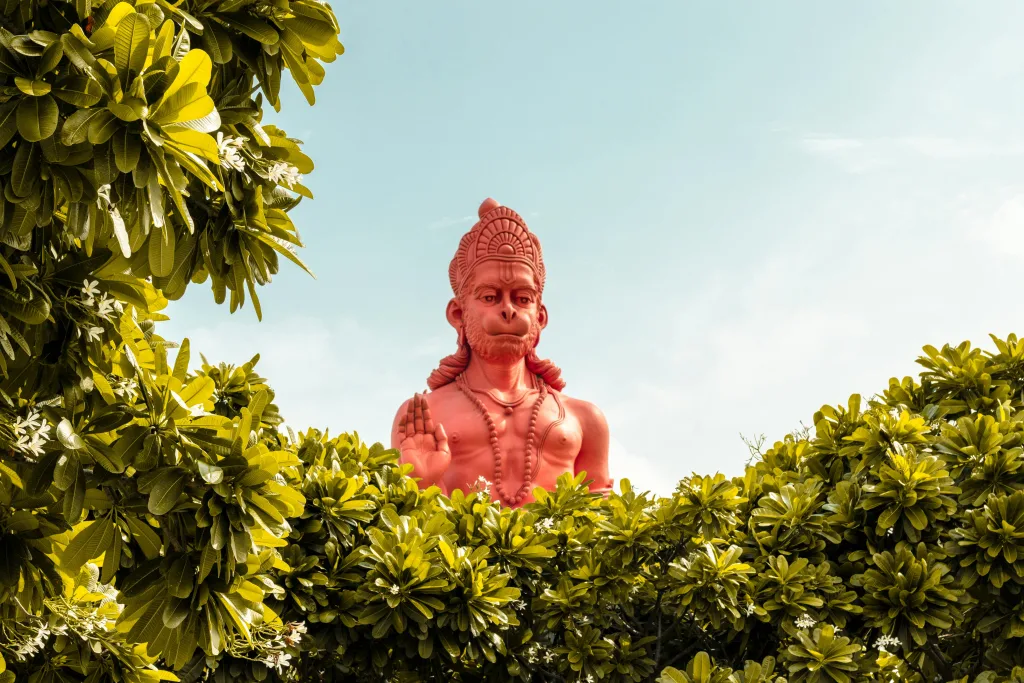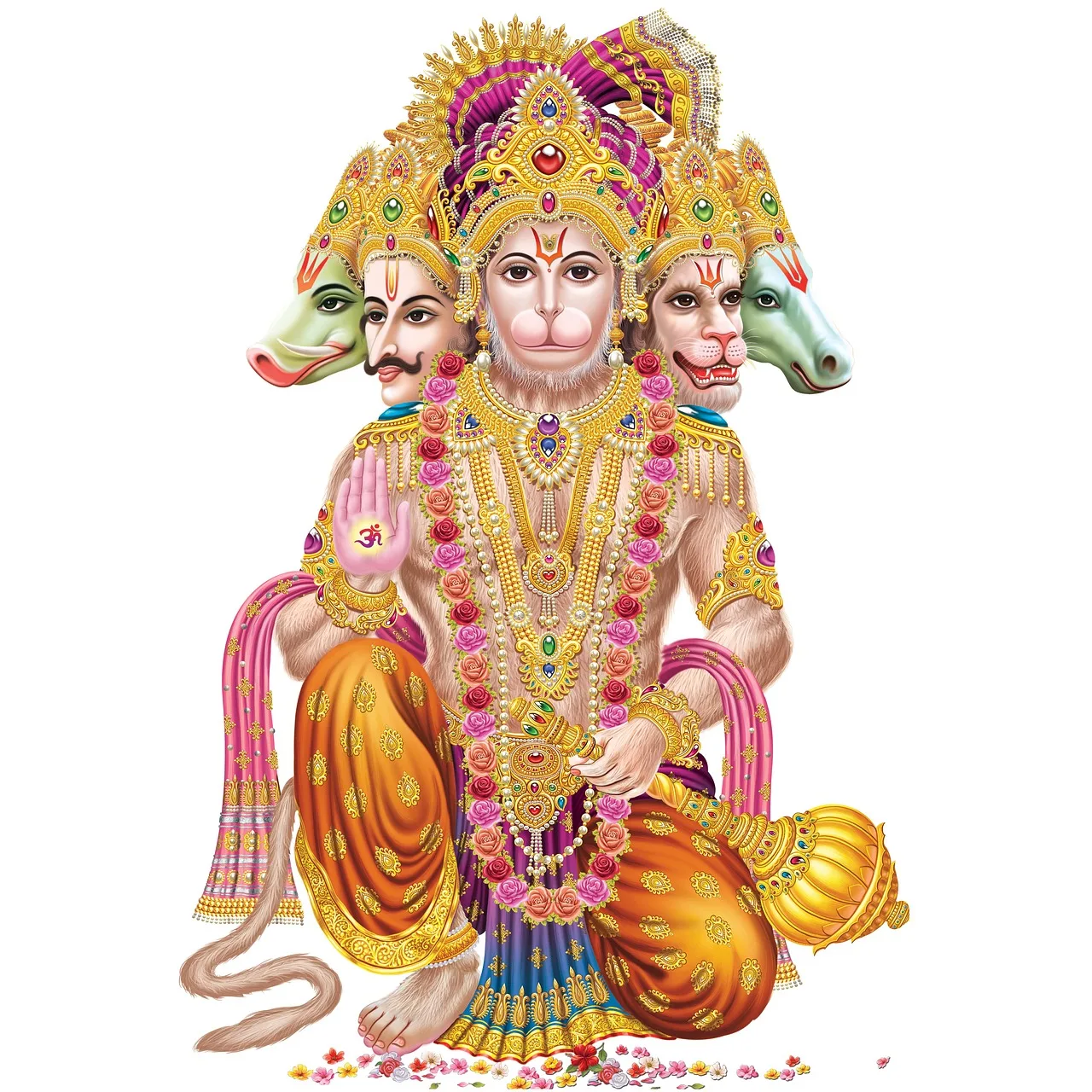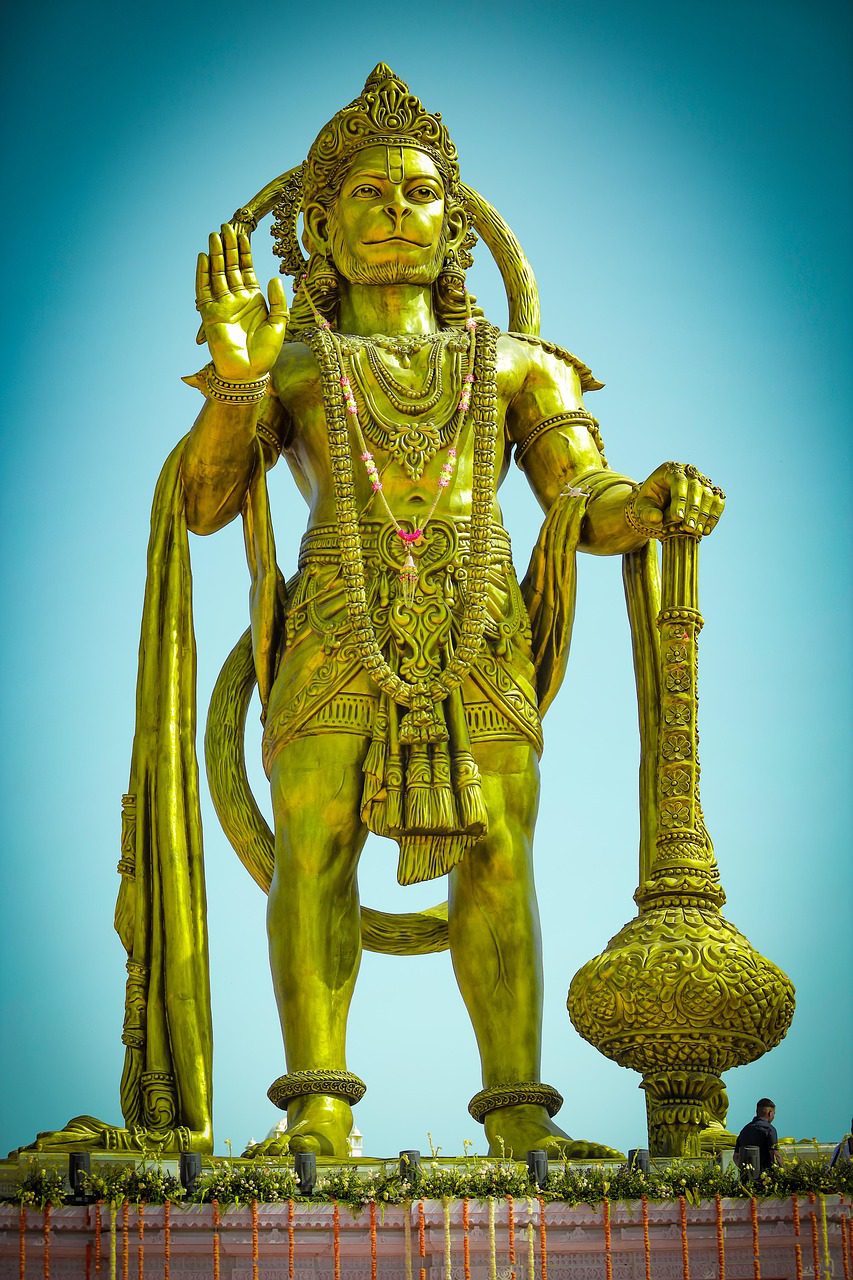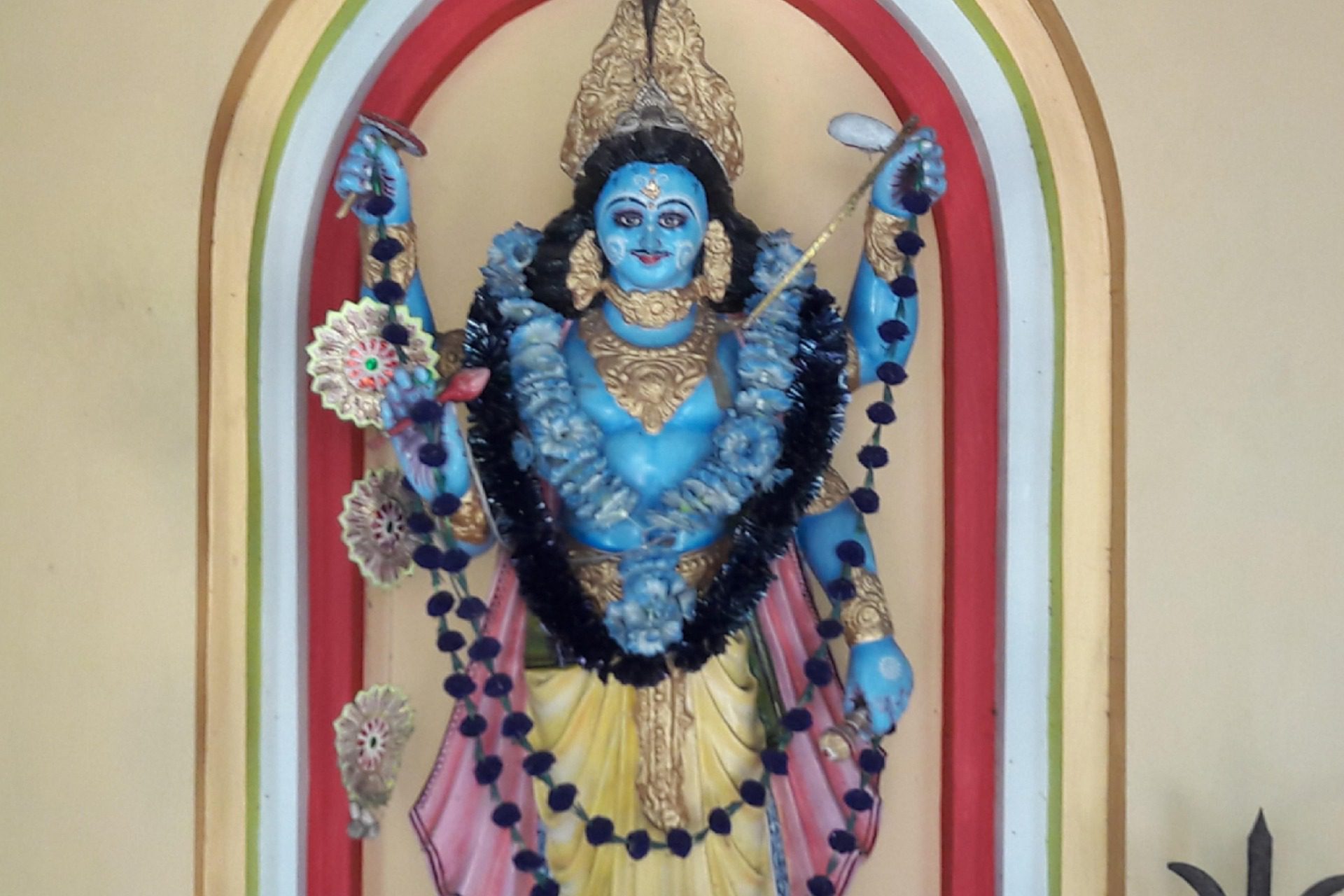Bajrang Baan (Full Text in Hindi):
दोहा:
निश्चय प्रेम प्रतीत ते, विनय करें सनमान।
तेहि के कारज सकल शुभ, सिद्ध करैं हनुमान॥
चौपाई:
जय हनुमंत सन्त हितकारी।
सुनि लीजै प्रभु अरज हमारी॥०१॥
जन के काज विलम्ब न कीजै।
आतुर दौरि महा सुख दीजै॥०२॥
जैसे कूदि सिंधु महि पारा।
सुरसा बदन पैठि विस्तारा॥०३॥
आगे जाय लंकिनी रोका।
मारेहु लात गई सुर लोका॥०४॥
जाय विभीषण को सुख दीन्हा।
सीता निरखि परम पद लीन्हा॥०५॥
बाग उजारी सिंधु महँ बोरा।
अति आतुर यम कातर तोरा॥०६॥
अक्षय कुमार मारि संहारा।
लूम लपेटि लंक को जारा॥०७॥
लाह समान लंक जरि गई।
जय जय धुनि सुर पुर महँ भई॥०८॥
अब विलम्ब केहि कारण स्वामी।
कृपा करहु उर अन्तर्यामी॥०९॥
जय जय लक्ष्मण प्राण के दाता।
आतुर होय दुख हरहु निपाता॥१०॥
जै गिरिधर जै जै सुखसागर।
सुर समूह समरथ भटनागर॥११॥
ॐ हनु हनु हनु हनुमन्त हठीले।
बैरिहिं मारु बज्र की कीले॥१२॥
गदा बज्र लै बैरिहिं मारो।
महाराज प्रभु दास उबारो॥१३॥
ॐकार हुंकार महाप्रभु धावो।
बज्र गदा हनु विलम्ब न लावो॥१४॥
ॐ ह्रीं ह्रीं ह्रीं हनुमंत कपीसा।
ॐ हुं हुं हुं हनु अरि उर शीशा॥१५॥
सत्य होहु हरि शपथ पाय के।
रामदूत धरु मारु धाय के॥१६॥
जय जय जय हनुमंत अगाधा।
दुःख पावत जन केहि अपराधा॥१७॥
पूजा जप तप नेम अचारा।
नहिं जानत कछु दास तुम्हारा॥१८॥
वन उपवन, मग गिरि गृह माहीं।
तुम्हरे बल हम डरपत नाहीं॥१९॥
पांय परौं कर जोरि मनावौं।
यह अवसर अब केहि गोहरावौं॥२०॥
जय अंजनि कुमार बलवंता।
शंकर सुवन वीर हनुमंता॥२१॥
बदन कराल काल कुल घालक।
राम सहाय सदा प्रतिपालक॥२२॥
भूत प्रेत पिशाच निशाचर।
अग्नि बेताल काल मारी मर॥२३॥
इन्हें मारु तोहि शपथ राम की।
राखु नाथ मरजाद नाम की॥२४॥
जनकसुता हरि दास कहावौ।
ताकी शपथ विलम्ब न लावौ॥२५॥
जय जय जय धुनि होत आकाशा।
सुमिरत होत दुसह दुःख नाशा॥२६॥
चरण शरण कर जोरि मनावौं।
यह अवसर अब केहि गोहरावौं॥२७॥
उठु उठु चलु तोहि राम दुहाई।
पांय परौं कर जोरि मनाई॥२८॥
ॐ चं चं चं चं चपल चलंता।
ॐ हनु हनु हनु हनु हनुमंता॥२९॥
ॐ हं हं हांक देत कपि चंचल।
ॐ सं सं सहमि पराने खल दल॥३०॥
अपने जन को तुरत उबारो।
सुमिरत होय आनन्द हमारो॥३१॥
यह बजरंग बाण जेहि मारै।
ताहि कहो फिर कौन उबारै॥३२॥
पाठ करै बजरंग बाण की।
हनुमत रक्षा करैं प्राण की॥३३॥
यह बजरंग बाण जो जापै।
तासों भूत प्रेत सब कांपै॥३४॥
धूप देय अरु जपै हमेशा।
ताके तन नहिं रहै कलेशा॥३५॥
दोहा:
प्रेम प्रतीतिहिं कपि भजै, सदा धरैं उर ध्यान।
तेहि के कारज सकल शुभ, सिद्ध करैं हनुमान॥

Overview of Bajrang Baan
Bajrang Baan is a profoundly revered devotional hymn dedicated to Lord Hanuman, composed by the legendary poet-saint Goswami Tulsidas, who also authored the epic Ramcharitmanas. The term “Bajrang” refers to Lord Hanuman, denoting his unparalleled strength and resilience, while “Baan” translates literally as “arrow.” Thus, Bajrang Baan symbolizes a divine arrow that swiftly eradicates negativity, difficulties, and evil influences from a devotee’s life.
Comprising primarily of a series of powerful verses (chaupais and dohas), Bajrang Baan eloquently depicts the heroic and miraculous deeds of Lord Hanuman during his quest to serve Lord Ram. Every verse is meticulously composed to highlight the incredible strength, wisdom, devotion, and the boundless compassion of Hanuman, who is worshipped as an embodiment of supreme dedication, bravery, and loyalty.
Chanting Bajrang Baan regularly is believed to yield immediate spiritual and practical benefits. Devotees commonly recite it to seek divine intervention, particularly in urgent or seemingly impossible situations, firmly believing that Lord Hanuman swiftly listens and responds to their sincere prayers. Because of its dynamic spiritual energy, the Bajrang Baan is prominently used in rituals aimed at eliminating hurdles, warding off malevolent forces such as evil spirits, black magic, and negative energies, and attracting divine blessings into one’s life.
The hymn is traditionally recited with unwavering devotion, primarily on Tuesdays and Saturdays, days considered auspicious for worshipping Hanuman. Moreover, special occasions such as Hanuman Jayanti witness heightened enthusiasm and collective chanting of the Bajrang Baan, magnifying its spiritual potency.
Additionally, the Bajrang Baan plays a vital role in Hindu culture due to its historical and spiritual significance. Originating during the Bhakti movement of medieval India—a period marked by deep spiritual awakening and devotional renaissance—it quickly spread among the masses, who found solace and strength in Hanuman’s unwavering faith and heroic exploits.
Over generations, Bajrang Baan has transcended geographical boundaries, becoming a crucial element in the global spiritual practices of Hindu devotees. Its widespread recognition and reverence across diverse communities illustrate its profound impact, extending beyond mere religious recitation and transforming into a cultural and spiritual phenomenon that fosters resilience, courage, and unwavering faith among practitioners.
Notably, while Bajrang Baan is renowned for its powerful and transformative effects, it is traditionally recommended to approach its recitation respectfully, ensuring one’s intentions are pure and devotional. Reciting with genuine faith and clarity of purpose significantly amplifies its positive spiritual outcomes, providing devotees with inner peace, clarity, and divine protection.
Thus, Bajrang Baan stands not merely as a hymn but as a sacred spiritual weapon, capable of bestowing strength, overcoming hardships, and illuminating one’s life with profound spiritual insights, peace, and blessings.
Meaning and Interpretation of Bajrang Baan
The Bajrang Baan carries deep spiritual meaning, symbolically crafted by Saint Tulsidas to invoke Lord Hanuman’s extraordinary strength, compassion, and divine grace. The hymn combines powerful metaphors and symbolic imagery to illustrate the incomparable virtues of Hanuman, primarily focusing on his unwavering loyalty, infinite courage, and tireless devotion towards Lord Ram.
The name itself, “Bajrang Baan”, holds profound symbolic significance. “Bajrang” signifies Hanuman, derived from “Vajra Ang,” meaning one whose body is as indestructible as a thunderbolt. “Baan” translates to “arrow,” indicating swiftness and precision in removing difficulties. Thus, Bajrang Baan represents a divine invocation, requesting Hanuman’s immediate intervention to eliminate negativity, obstacles, and evil influences swiftly, just as an arrow precisely hits its target.
Each verse meticulously narrates episodes from Hanuman’s legendary acts during his heroic journey to Lanka, portraying his unmatched courage and relentless determination. For instance, the hymn vividly recalls Hanuman’s extraordinary leap across the ocean, his encounter and victory over demoness Surasa, defeating Lankini with ease, comforting Vibhishana, reassuring Mother Sita, and courageously setting fire to Lanka, symbolizing the eradication of negativity and injustice.
Metaphorically, Bajrang Baan serves as a spiritual shield and weapon, empowering devotees to confront inner fears, overcome personal and external challenges, and achieve success through divine intervention. The hymn encapsulates the core Hindu philosophy of absolute surrender to divinity, teaching followers to place unwavering faith and reliance on the almighty’s boundless power and compassion.
Moreover, the repetitive chanting of specific syllables and mantras within Bajrang Baan, such as “ॐ हनु हनु हनुमंता” and “ॐ ह्रीं ह्रीं ह्रीं हनुमंत कपीसा,” holds profound significance. These potent vibrations are believed to resonate deeply with universal energies, enhancing spiritual awareness, internal strength, and divine alignment.
Bajrang Baan is traditionally interpreted as a spiritual catalyst, designed to ignite inner resilience and swiftly destroy obstacles—both material and spiritual. Its recitation is not merely symbolic; practitioners genuinely experience its transformative power, gaining clarity of purpose, increased self-confidence, spiritual protection, and peace of mind.
Thus, understanding Bajrang Baan extends beyond mere literal interpretation. It involves comprehending the depth of its symbolism, appreciating the spiritual and emotional transformation it encourages, and recognizing its timeless role as a divine invocation for strength, protection, and unwavering faith.
Historical Context of Bajrang Baan
Bajrang Baan finds its roots deep within the spiritually transformative Bhakti movement of medieval India, a profound religious renaissance that flourished between the 14th and 17th centuries. This period saw a surge of devotional fervor, where poets and saints utilized their literary genius to bridge the gap between common people and the divine. It was during this spiritually fertile era that Saint Goswami Tulsidas emerged, a revered poet and a leading spiritual figure in northern India.
Tulsidas, born in 1532 CE, is widely celebrated for his monumental literary contribution, the Ramcharitmanas—an epic retelling of Lord Ram’s life in vernacular Awadhi language. His works significantly influenced Hindu spirituality, spreading devotion and morality amongst the masses who previously struggled to access religious teachings due to linguistic or social barriers.
In addition to Ramcharitmanas, Tulsidas composed several other influential texts, among which Bajrang Baan holds a unique and distinguished place. Though shorter in length compared to Ramcharitmanas, Bajrang Baan quickly gained widespread recognition due to its potency and immediacy in addressing life’s adversities. Tulsidas intended this hymn not only as an homage to Lord Hanuman but also as a divine solution for devotees in times of distress or peril.
Historically, Bajrang Baan’s recitation began as a tradition among warrior communities and devout followers who sought strength, courage, and divine protection in challenging circumstances. Gradually, the hymn transcended these boundaries, becoming a universal spiritual practice among people of all backgrounds. Over generations, it became integrated into Hindu rituals and daily prayers, especially revered by those seeking swift resolution of troubles, spiritual protection, and mental fortitude.
The hymn’s historical legacy is intricately linked to Hanuman’s representation as a deity embodying fearlessness, devotion, strength, and loyalty. Tulsidas skillfully captured these attributes, making the Bajrang Baan a timeless spiritual resource capable of resonating across centuries.
Today, Bajrang Baan’s historical significance continues to thrive globally, extensively recited in temples and homes. Its consistent popularity underscores its relevance in contemporary spiritual practices, highlighting the enduring power of Tulsidas’ vision of devotion and spiritual empowerment, which has withstood the test of time.
If you want to Know more About Monkey temple in Nepal Visit yetirajtreks.com and read detailed information On Monkey temple.
Benefits of Chanting Bajrang Baan (380 Words)
The practice of chanting Bajrang Baan offers numerous spiritual, emotional, psychological, and physical benefits, deeply rooted in Hindu traditions and universally recognized among devotees worldwide. Believed to be among the most powerful Hanuman mantras, this sacred hymn is extensively recited for its profound transformative effects, bringing peace, protection, and prosperity into the lives of its practitioners.
1. Removal of Obstacles and Difficulties
One of the foremost benefits of reciting Bajrang Baan is its powerful ability to swiftly eliminate obstacles and resolve prolonged issues. Devotees experiencing difficulties in their personal, professional, or spiritual lives frequently turn to this mantra as a remedy. It is believed that sincere chanting invites Lord Hanuman’s swift divine intervention, helping devotees overcome seemingly insurmountable barriers.
2. Protection from Evil and Negative Energies
Bajrang Baan acts as a potent spiritual shield against evil forces such as negative energies, evil spirits, black magic, and harmful intentions. Its strong spiritual vibrations purify the environment, warding off malevolent influences. Regular chanting ensures comprehensive spiritual protection, creating an aura of positivity and safeguarding devotees and their homes from negativity.
3. Mental Peace and Emotional Stability
Chanting Bajrang Baan is associated with remarkable psychological and emotional benefits, such as reduced anxiety, stress relief, and increased emotional resilience. Its rhythmic recitation has a calming effect, allowing practitioners to experience tranquility, clarity, and heightened spiritual awareness. Regular practice enhances mental strength, fostering a balanced state of mind and emotional stability amidst life’s challenges.
4. Spiritual Enlightenment and Personal Growth
Continuous chanting of Bajrang Baan deeply connects devotees with the divine, fostering spiritual enlightenment and personal growth. The mantra facilitates inner awakening, strengthening devotion and enhancing clarity of thought. As practitioners immerse themselves in its spiritual essence, they experience profound inner transformation, aligning more closely with divine virtues such as compassion, humility, courage, and dedication.
5. Physical Well-being and Health
Many devotees firmly believe in the physical benefits offered by Bajrang Baan, citing improvements in general health, increased vitality, and recovery from ailments. Regular chanting is considered to fortify the body’s internal strength, boosting immunity, energy levels, and overall physical resilience.
Thus, the benefits of Bajrang Baan extend far beyond religious practice, touching every aspect of human life. Its profound impact manifests in overcoming life’s adversities, ensuring spiritual and emotional well-being, and achieving overall harmony and prosperity.
Interesting Facts About Bajrang Baan (380 Words)
The Bajrang Baan is not only a spiritually significant hymn but also filled with intriguing facts and anecdotes that enhance its value and appeal among devotees globally. Here are several captivating facts about this powerful devotional chant dedicated to Lord Hanuman:
1. Composed by Tulsidas, the Renowned Poet-Saint
The Bajrang Baan was composed by the revered poet-saint Goswami Tulsidas, who is famously known for authoring the epic scripture Ramcharitmanas. His literary contributions are treasured for their spiritual depth, linguistic brilliance, and accessibility to common people.
2. Considered More Powerful During Specific Days
While Bajrang Baan can be recited at any time, chanting it specifically on Tuesdays and Saturdays amplifies its spiritual potency. These days are traditionally associated with Lord Hanuman, making them particularly auspicious for devotion and rituals.
3. Recommended Frequency of Chanting
Devotees often chant Bajrang Baan in multiples of 11, 21, or 108 times. The number 108 holds deep spiritual significance in Hindu traditions, symbolizing completeness, unity, and spiritual alignment. Regular recitation of Bajrang Baan in these numbers is believed to magnify its effectiveness.
4. Connection with Hanuman Chalisa
Bajrang Baan shares its divine roots with another highly revered hymn—Hanuman Chalisa. Both composed by Tulsidas, these sacred chants complement each other spiritually. While Bajrang Baan emphasizes swift removal of obstacles, Hanuman Chalisa promotes overall devotion and spiritual protection. To deeply understand the relationship between these two powerful hymns, explore our detailed guide on Hanuman Chalisa Meaning and Benefits.
5. Significance during Hanuman Jayanti
Hanuman Jayanti, celebrated to honor Hanuman’s birth, witnesses a significant surge in collective chanting of Bajrang Baan across temples and homes. Devotees believe that reciting this hymn during this auspicious festival invites abundant blessings, divine grace, and prosperity.
6. Spiritual Remedy against Negative Energies
Historically, Bajrang Baan has been specifically recommended as an effective spiritual remedy against paranormal occurrences, negative energies, and other harmful influences. Its verses are believed to possess protective energies that neutralize negativity and restore harmony.
Thus, Bajrang Baan’s intriguing aspects extend beyond its spiritual potency, embedding it deeply in the devotional practices and cultural fabric of Hindu spirituality. These fascinating details continue to inspire and enrich its recitation among devotees worldwide, making it a timeless spiritual treasure.
How to Chant Bajrang Baan: Rituals and Recommendations (380 Words)
Chanting Bajrang Baan with sincerity, devotion, and adherence to specific rituals maximizes its profound spiritual benefits. Below is a detailed guideline for performing Bajrang Baan recitation effectively and correctly, ensuring optimal spiritual results:
1. Choosing an Auspicious Time
Traditionally, Bajrang Baan chanting is most potent when performed on Tuesdays and Saturdays, days associated with Lord Hanuman. Additionally, early mornings, especially during Brahmamuhurta (approximately one and a half hours before sunrise), are highly recommended due to their spiritual purity and heightened cosmic energy.
2. Preparations for Chanting
Before recitation, it is customary to bathe or cleanse oneself physically and spiritually. Wearing clean and preferably red or saffron-colored clothing further enhances devotion, aligning oneself with the powerful energies represented by Lord Hanuman.
3. Creating a Sacred Space
Establishing a peaceful and spiritually conducive environment significantly influences the effectiveness of chanting. Place a picture or idol of Lord Hanuman in your prayer area, decorating it with flowers, lighting a diya (lamp), and burning incense sticks to create a spiritually uplifting atmosphere.
4. Chanting Frequency and Method
While the Bajrang Baan can be recited once daily, devotees seeking specific resolutions or spiritual protection often chant it in multiples of 11, 21, or ideally 108 times. Repeating the chant systematically amplifies its spiritual power, aiding quicker resolution of problems and strengthening the devotee’s bond with Lord Hanuman.
5. Complementing with Other Chants
Many devotees enhance their spiritual experience by complementing Bajrang Baan with related chants, particularly the Shani Chalisa, as Lord Hanuman is believed to mitigate adverse effects associated with Lord Shani. Chanting both hymns together is considered highly auspicious, alleviating challenges posed by Saturn’s transit or “Shani Sade Sati.” You can further explore the deep spiritual significance and benefits of chanting the Shani Chalisa here.
6. Concluding the Chant
Upon completing the chanting, it is beneficial to sit quietly for a few minutes, absorbing the hymn’s vibrations and meditating upon Lord Hanuman’s divine form and virtues. Conclude by offering sincere prayers, expressing gratitude, and seeking blessings for protection, courage, strength, and success.
By following these rituals with devotion, sincerity, and consistency, devotees can experience significant spiritual growth, protection, and fulfillment of desires, thereby truly unlocking the transformative power embedded in the sacred verses of Bajrang Baan.




